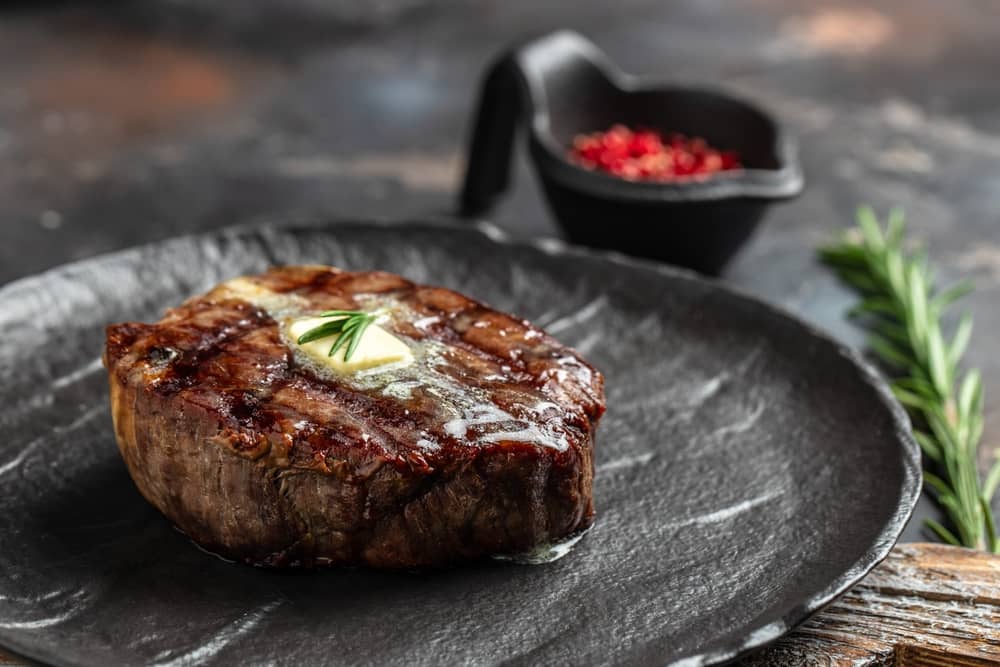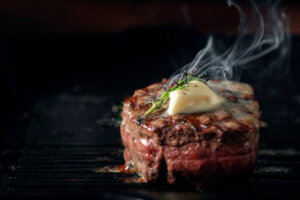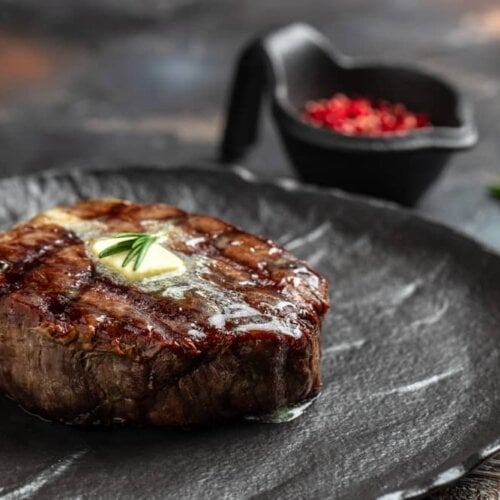
Once you get the hang of it, steak is actually one of the quickest and easiest foods to cook. Using the traditional cooking methods of grilling or pan-searing, you can cook most steaks under 20 minutes, ready for you to place on a plate and enjoy. Why throw another cooking method into the mix to learn?
The reverse sear method for steaks is one you won’t want to skip if you’re eating a thick steak like filet mignon. It sounds trickier than it is, so don’t get discouraged. The reverse sear is an excellent way to make sure your thick filet mignons come to the perfect temperature, finished off with the most delicious sear you can imagine.
What is the Filet Mignon Reverse Sear Method?
Filet mignon is one of the thickest cuts of steak, so it can be one of the trickiest to cook. It’s tough to get the internal temperature just right without having to keep poking the insides with a meat thermometer and letting the juices escape.
The filet mignon reverse sear method can take some of the guesswork out of getting the right temperature by letting the meat cook slowly to medium-rare and then giving it a sear in the skillet right before enjoying it. When you reverse the traditional cooking method of searing and then baking a filet mignon, you can get a more accurate internal temperature without risking a too-crispy outer crust.
A reverse sear gives filet mignon the time it needs to cook without drying up. A quick sear in the pan after baking delivers just the right amount of crispy crust to elevate its flavor.
Choosing the Best Filet Mignon for Reverse Seared Steak
You’ve decided you want to reverse sear filet mignon. Great! Your first step should be to look for the best tenderloin to find stand-out filet mignon steak that’s perfect for the reverse sear method.
The first thing you’ll want to look for is coloring. Fresh, healthy filets will have a deep red color compared to ones that aren’t as fresh, which will usually be paler. Preferably, you can ask the butcher to slice some filets fresh for you.
Also, check out the marbling. Filet mignons naturally have less fat than other cuts, like ribeye. However, some tenderloin steak has more fat marbling than others. You can usually tell by looking at it. Marbling is the lighter-colored strands that run through the meat. It might even give the filet an overall lighter appearance compared to others. With more fat content typically comes more flavor.
Maybe you don’t want to spend time at the supermarket or butcher looking for the perfect beef tenderloin for your reverse sear steak recipe. No worries — Chicago steak company has some of the best beef tenderloin filet mignon ready to ship to your home. Order filet mignon online from us, and receive hand-cut and hand-selected filets vacuum-sealed and packed with care.
Benefits of Reverse-Searing Filet Mignon
The filet mignon reverse-sear method can take some of the guesswork out of getting the right temperature by letting the meat cook slowly to medium-rare and then giving it a sear in the skillet right before enjoying it. When you reverse the traditional cooking method of searing and then baking a filet mignon, you can get a more accurate internal temperature without risking a too-crispy outer crust.
A reverse-sear gives filet mignon the time it needs to cook without drying up. A quick sear in the pan after baking delivers just the right amount of crispy crust to elevate its flavor.
Disadvantages of Reverse-Searing Filet Mignon
There are pros and cons to every cooking method, and the same is true for reverse-searing. First, this method takes more time than a traditional steak cook of searing then finishing, since you’re slowly bringing the steak up to temp before searing it. So, it’s not as ideal for a quick weeknight dinner (you’ll at least need to plan for a little more cooking time). You’ll also need both an oven and a stovetop or an oven and a grill, which can be a drawback if you’re short on space or equipment.
Finally, while the reverse-sear method offers excellent temperature control for filet mignon, the final sear requires a little practice to time right. Too long in the pan, and you could overcook that perfect center.
Reverse-Searing Tips and Tricks
Pull off a steakhouse-quality filet mignon cook right in your kitchen using these expert tips and tricks:
- Let the filet come to room temperature: Before you start cooking, take the filet out of the fridge for 30-45 minutes. A room-temperature steak cooks more evenly from edge to center.
- Use a wire rack on a baking sheet: Elevating the steak during the oven phase allows air to circulate, helping it cook evenly and dry out the exterior for a better sear.
- Don’t skip the rest between oven and sear: Let the filet rest for 5-10 minutes after the oven to allow juices to settle and the outer surface to cool just slightly. This prevents overcooking during the sear.
- Give your pan plenty of heat: A hot cast iron pan is the key to getting a beautiful crust fast, so you don’t end up cooking the inside further.
- Finish with butter and aromatics: Toss in a pat of butter, garlic, or rosemary during the searing portion to give your filet an extra boost of steakhouse flavor (bonus: it helps the crust form, too!).
Temperature and Timing
Getting the temperature and timing right is key to a successful reverse-sear on filet mignon. Because filet is thick and lean, you want to bring it up to your target internal temperature slowly to avoid overcooking. For medium-rare, aim to pull the steak from the oven when it hits about 110-115 degrees. It’ll gain a few more degrees during the sear and resting phase, landing right in the sweet spot of 130-135 degrees.
Set your oven to a low temperature of around 250-275 degrees and expect the cook time to range from 30 to 45 minutes, depending on the steak’s thickness. Use a meat thermometer to track temperature accurately. Once you hit your target pre-sear temp, rest the steak for 5-10 minutes, then finish it off in a hot skillet for about 45-60 seconds per side. Overall, you’ll typically need about an hour to reverse-sear filet mignon.
How to Reverse Sear Filet Mignon
Have we piqued your interest yet? Good! The reverse sear method is as easy to learn as the others you’re used to, and it may even become your new go-to way to cook filet mignon at home. Here’s how to do it.
Prepare the Filet Mignon
To begin, remove the filet mignon steaks from the refrigerator and place them on a plate. Then, pat the filet mignon steaks dry and season generously with salt. Allow to sit for 30-45 minutes at room temperature. This ensures a more even cooking temperature when you’re ready to cook them and gives them a chance to brine, which results in a crispy sear.
Before cooking, spray a thin layer of cooking spray on your oven-safe pan or cast iron skillet. Place the pan in the oven while you preheat it to 250 degrees. Then, sprinkle pepper on all sides to taste. We also recommend trying out Chicago Steak Seasoning, which adds bold flavor to filet mignon.

Cook the Reverse Seared Filet Mignon
Remove the pan from the oven, add the filets, and place the pan back in the oven. Cook for 45-60 minutes. A thicker steak may need a bit more time. If desired, all a little garlic butter or olive oil on top of the filets and in the pan to keep the reverse seared steak juicy.
Check the internal temperature of each filet with a meat thermometer. The ideal cook for filet mignon is medium-rare, and for this cook, you’ll want to remove steaks from the oven when the thermometer reads between 125 to 130-degrees (130 to 135-degrees for medium and about 120-degrees for rare).
Now, it’s time to make reverse sear beef tenderloin. Once the steaks hit your desired internal temperature, place them on a plate tented with foil for 10 minutes to rest. Meanwhile, preheat a cast iron skillet over high heat with a couple of tablespoons of garlic butter or olive oil.
Add the beef to the heated pan. Sear steak for 2-3 minutes on the bottom side until a golden-brown crust forms. Then, flip to the other side to sear for another 2-3 minutes. If desired, hold filets on their sides to crisp up the edges too.

What To Do After Cooking Reverse Seared Filet Mignon
Your filet mignon is almost ready to dig into. After using the reverse sear method to crisp up the outside of the filets, transfer the seared steak to a cutting board or plate tented with foil. Allow to rest again for 5-10 minutes to let the steak’s juices absorb back into the meat.
Then, the choice is yours. Add a sprinkle of steak seasoning and kosher salt, if desired. Or, add a pat of herbed or garlic butter to the top of each filet just before serving. Most importantly, enjoy!

Reverse-Sear Filet Mignon Recipe
Ingredients
- 2 filet mignon steaks
- Kosher salt
- Freshly ground black pepper
- 1 tablespoon olive oil
- 1 tablespoon butter
- 1-2 sprigs fresh rosemary or thyme
- 1 garlic clove, smashed
Instructions
- Bring steaks to room temperature for 30-45 minutes before cooking. Preheat your oven to 250-275°F.
- Pat steaks dry and season generously with salt and pepper on all sides.
- Place the steaks on a wire rack set over a baking sheet.
- Bake in the oven for 30-45 minutes, or until the internal temperature reaches 110-115°F for medium-rare.
- Remove steaks from the oven and let rest for 5-10 minutes.
- While the steaks rest, heat a cast-iron skillet over high heat until very hot.
- Add olive oil to the skillet. Once shimmering, add the steaks. Sear each side for 45-60 seconds.
- During the last 30 seconds, add butter, smashed garlic, and herbs to the pan. Spoon the melted butter over the steaks as they finish searing.
- Remove from the skillet and let rest 5 minutes before serving.
Conclusion: Reverse Sear Filet Mignon
The filet mignon is a steak cut that can go either very wrong or very right, depending on how you cook it. Since one of the most challenging aspects of cooking filets is preventing it from overcooking, you may want to try the reverse sear method to make the process a little easier. You’ll also have the benefit of getting a fresh crust on the outside edges of the steak, which ups the already-tasty factor of filet mignon. Check out our Premium Angus Filet Mignon, or USDA Prime Wet Aged filets, or American Wagyu filets and order them online for home delivery!

Reverse-Sear Filet Mignon
Ingredients
- 2 filet mignon steaks
- Kosher salt
- Freshly ground black pepper
- 1 tablespoon olive oil
- 1 tablespoon butter
- 1-2 sprigs fresh rosemary or thyme
- 1 garlic clove smashed
Instructions
- Bring steaks to room temperature for 30-45 minutes before cooking. Preheat your oven to 250-275°F.
- Pat steaks dry and season generously with salt and pepper on all sides.
- Place the steaks on a wire rack set over a baking sheet.
- Bake in the oven for 30-45 minutes, or until the internal temperature reaches 110-115°F for medium-rare.
- Remove steaks from the oven and let rest for 5-10 minutes.
- While the steaks rest, heat a cast-iron skillet over high heat until very hot.
- Add olive oil to the skillet. Once shimmering, add the steaks. Sear each side for 45-60 seconds.
- During the last 30 seconds, add butter, smashed garlic, and herbs to the pan. Spoon the melted butter over the steaks as they finish searing.
- Remove from the skillet and let rest 5 minutes before serving.


